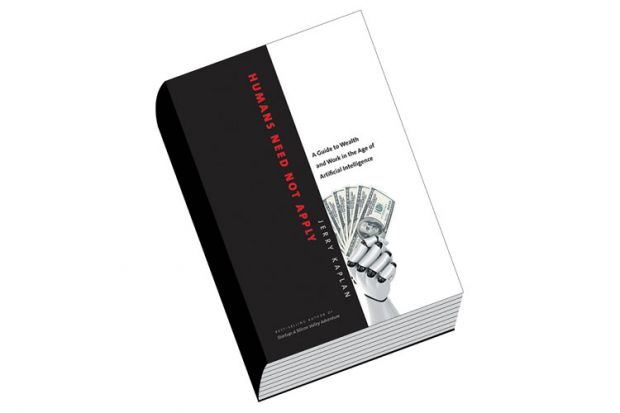As a science-fiction writer, I am happy to admit that artificial intelligence regularly gets a bad press in the more popular tales of the future. So much so, in fact, that the term almost inevitably conjures up images of murderous red-eyed robots stalking through ravaged dystopian cities, sentient computer networks taking over the world to rid it of the blight that is humanity, or the stark, chillingly calm voice of 2001: A Space Odyssey’s HAL 9000 as it declines to open the airlock door.
In Humans Need Not Apply, Jerry Kaplan, a computer industry veteran who is now a fellow in Stanford University’s Center for Legal Informatics, leaves behind the deadly archetypes of speculative fiction to take a broad look at artificial intelligence as a real-world area of study. He draws on his knowledge of the computer industry and the economy in general to provide some illustrations – and timely warnings – regarding the likely near future of this important field.
Each section of the book covers an area in which AI has the potential to have a significant impact on the way human society and economics operate today. Everything from investment to healthcare to personal transport to house painting is discussed – some illustrated with thumbnail “future histories” of how artificial intelligence might disrupt the current model.
The minds behind large-scale AI developments, Kaplan notes, are particularly interested in industries where it can make a disruptive impact – think taxi services and online booksellers – because it is in disruption that the highest profit rests. Where there are major new directions in industries and markets there will inevitably be a significant human impact, and Kaplan leads us through examples from his own recent experience that show just how painful this can – and will – be for the potential digital underclass.
Describing himself as a technology entrepreneur, Kaplan is refreshingly open about the fact that he is well off. He describes his enviable lifestyle in some detail, but is at pains to point out that he is not a member of the super-rich elite of the US. Pointing to his humble background, he argues that he is in a position to see both sides of the picture – and he expresses his concern about the top 1 per cent of the population having such an overwhelming control of the economy, and the ability to distort it.
This book is as much about society and economics as it is about computer science – and the breadth of the material it covers means that readers are occasionally left wanting more detail. Some of the topics discussed are illustrated with almost throwaway examples that sent me scurrying for the references in search of clarification. This brevity may be explained by the comment in the acknowledgements that the book is based on a series of lectures he taught at Stanford’s AI Lab – which I suspect would have been well worth attending.
In some ways, this is a book about Silicon Valley written by a long-term Silicon Valley insider for Silicon Valley folk. As a collection of current thinking from this often insular community, it would be a valuable snapshot for that reason alone, but Humans Need Not Apply also serves as a reminder that AI systems don’t need red laser eyes to be dangerous.
John Gilbey teaches in the department of computer science at Aberystwyth University.
Humans Need Not Apply: A Guide to Wealth and Work in the Age of Artificial Intelligence
By Jerry Kaplan
Yale University Press, 256pp, £20.00
ISBN 9780300213553
Published 3 September 2015
POSTSCRIPT:
Print headline: Please adjust your mindset
Register to continue
Why register?
- Registration is free and only takes a moment
- Once registered, you can read 3 articles a month
- Sign up for our newsletter
Subscribe
Or subscribe for unlimited access to:
- Unlimited access to news, views, insights & reviews
- Digital editions
- Digital access to THE’s university and college rankings analysis
Already registered or a current subscriber? Login




